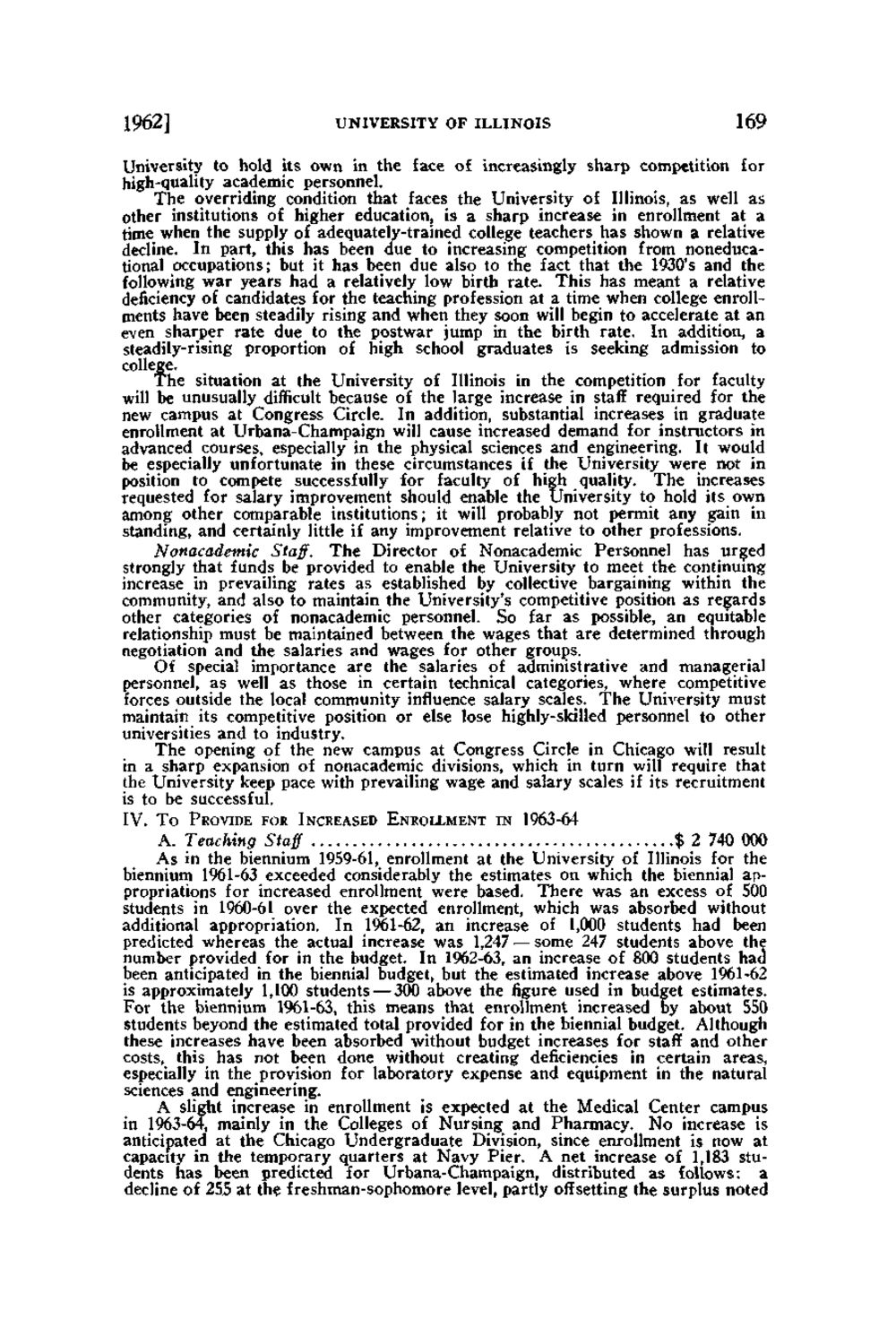| |
| |
Caption: Board of Trustees Minutes - 1964
This is a reduced-resolution page image for fast online browsing.

EXTRACTED TEXT FROM PAGE:
1962] UNIVERSITY OF ILLINOIS 169 University to hold its own in the face of increasingly sharp competition for high-quality academic personnel. The overriding condition that faces the University of Illinois, as well as other institutions of higher education, is a sharp increase in enrollment at a time when the supply of adequately-trained college teachers has shown a relative decline. In part, this has been due to increasing competition from noneducational occupations; but it has been due also to the fact that the 1930's and the following war years had a relatively low birth rate. This has meant a relative deficiency of candidates for the teaching profession at a time when college enrollments have been steadily rising and when they soon will begin to accelerate at an even sharper rate due to the postwar jump in the birth rate. In addition, a steadily-rising proportion of high school graduates is seeking admission to college. T h e situation at the University of Illinois in the competition for faculty will be unusually difficult because of the large increase in staff required for the new campus at Congress Circle. In addition, substantial increases in graduate enrollment at Urbana-Champaign will cause increased demand for instructors in advanced courses, especially in the physical sciences and engineering. It would be especially unfortunate in these circumstances if the University were not in position to compete successfully for faculty of high quality. The increases requested for salary improvement should enable the University to hold its own among other comparable institutions; it will probably not permit any gain in standing, and certainly little if any improvement relative to other professions. Nonacademic Staff. T h e Director of Nonacademic Personnel has urged strongly that funds be provided to enable the University to meet the continuing increase in prevailing rates as established by collective bargaining within the community, and also to maintain the University's competitive position as regards other categories of nonacademic personnel. So far as possible, an equitable relationship must be maintained between the wages that are determined through negotiation and the salaries and wages for other groups. Of special importance are the salaries of administrative and managerial personnel, as well as those in certain technical categories, where competitive forces outside the local community influence salary scales. T h e University must maintain its competitive position or else lose highly-skilled personnel to other universities and to industry. The opening of the new campus at Congress Circle in Chicago will result in a sharp expansion of nonacademic divisions, which in turn will require that the University keep pace with prevailing wage and salary scales if its recruitment is to be successful. IV. To PROVIDE FOR INCREASED ENROLLMENT IN 1963-64 A. Teaching Staff $ 2 740 000 As in the biennium 1959-61, enrollment at the University of Illinois for the biennium 1961-63 exceeded considerably the estimates on which the biennial appropriations for increased enrollment were based. There was an excess of 500 students in 1960-61 over the expected enrollment, which was absorbed without additional appropriation. In 1961-62, an increase of 1,000 students had been predicted whereas the actual increase was 1,247 — some 247 students above the number provided for in the budget. In 1962-63, an increase of 800 students had been anticipated in the biennial budget, but the estimated increase above 1961-62 is approximately 1,100 students — 300 above the figure used in budget estimates. For the biennium 1961-63, this means that enrollment increased by about 550 students beyond the estimated total provided for in the biennial budget. Although these increases have been absorbed without budget increases for staff and other costs, this has not been done without creating deficiencies in certain areas, especially in the provision for laboratory expense and equipment in the natural sciences and engineering. A slight increase in enrollment is expected at the Medical Center campus in 1963-64, mainly in the Colleges of Nursing and Pharmacy. No increase is anticipated at the Chicago Undergraduate Division, since enrollment is now at capacity in the temporary quarters at Navy Pier. A net increase of 1,183 students has been predicted for Urbana-Champaign, distributed as follows: a decline of 255 at the freshman-sophomore level, partly offsetting the surplus noted
| |